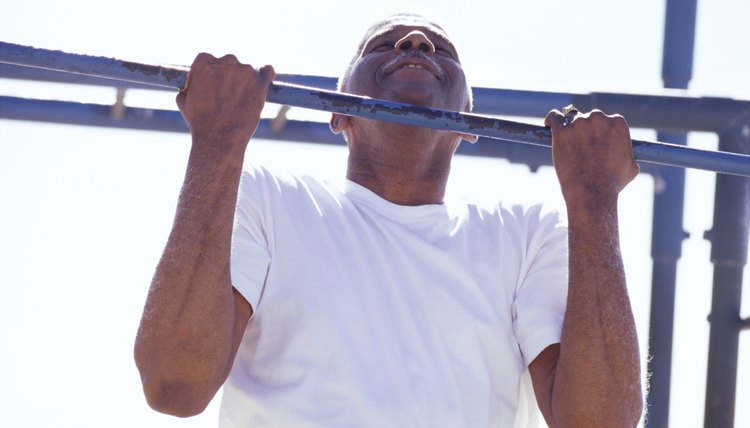Are Both Wide Grip and Close Grip Chin-Ups Good for the Biceps?

Chinups are one of those exercises you love to hate -- they say a lot about your upper-body strength, yet are still a very challenging exercise. Chinups are primarily considered a back exercise, but they also considerably tax your biceps. The use of a wide grip and narrow grip for chinups will alter to what extent each muscle is used, but both grips are good for the biceps.
Proper Chinup Technique
No matter what grip you choose to use, if you don't have proper technique for your chinups, you won't get the desired results. Begin by hanging from a fixed bar with an underhand grip and your arms extended. The standard chinup is performed with your hands shoulder-width apart -- move in or out from here to make your grip narrow or wide. If your grip is too wide, range of motion will be compromised. Bend your arms to pull your chest up to the bar. Exhale at the top of the movement, then slowly lower back to the starting position.
Target Muscles
All versions of the chinup work the same muscles -- the latissimus dorsi, or lats, teres major, rhomboids, trapezius, pectorals, biceps brachii and brachialis. To what extent the muscles are worked can be altered by your grip. A wide grip will put more emphasis on your lats, while a narrow grip will put more emphasis on your upper back and biceps.
Totally Tax Your Biceps
Even though your biceps work hard to bend your elbows and pull your body up to the bar, they can do so much more during the rest of the exercise. Pause at the top of the exercise and force your biceps to maintain an isometric contraction for one to two seconds. Your biceps lengthen and eccentrically contract as you lower yourself from the bar. During this phase, go as slowly as possible to really get the burn going in your upper arms. Beware, however, that eccentric contractions can cause significant muscle soreness, so do this only a few times during each workout.
Chinup Workout Tips
Chinups can help significantly improve your upper-body strength but only if you can complete at least one. If you find yourself unable to quite reach the bar, have a workout buddy help you or use a resistance band for assistance. If you're on the other end of the spectrum and are no longer challenged by mere body-weight chinups, add some weight with a weight belt or hold a dumbbell between your feet.
References
- Strength Training Anatomy, Second Edition; Frederic Delavier
- ExRx.net: Chin-up
- ExRx.net: Assisted Chin-up (partner)
- ExRx.net: Weighted Chin-up
Resources
Writer Bio
Jen Weir writes for several websites, specializing in the health and fitness field. She holds a Bachelor of Science in exercise science from Montana State University, is an NSCA-certified strength and conditioning specialist and maintains a personal trainer certification from the American College of Sports Medicine.
